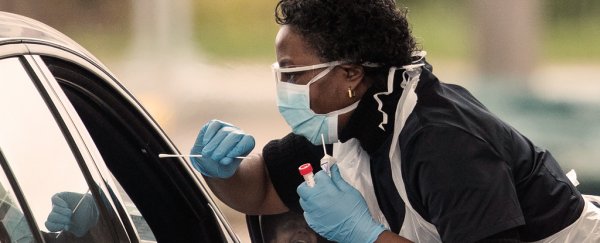"Know thy enemy," Sun Tzu advised in The Art of War. That axiom rings true not just for military strategists, but also for your immune system: Your body might "know" the flu, either from a prior infection or a vaccine.
That familiarity makes the flu easier to vanquish than the novel coronavirus sparking the current pandemic.
Beyond a lack of immunity, testing mishaps and unproven treatments make the novel coronavirus pandemic a new and distinct challenge from influenza outbreaks, which researchers have been working to control for decades.
No herd immunity
During flu season – even a severe one – much of the population is already immune. Your immune system might recognise the viral enemy from a previous infection and pump out antibodies to clear the contagion. Or you might have received a flu shot, a dose of dead influenza viruses that trains your body to fend off a live attack.
People with immunity, whether by infection or injection, help keep the greater public relatively safe from the flu, according to Abigail Carlson, an infectious disease specialist at Washington University in St. Louis.
"When the virus infects them, it reaches a dead end," Carlson told Business Insider. "They don't get sick, they don't pass it on. And they stop the virus in its tracks."
This protective process is called herd immunity. While not perfect – tens of thousands of Americans die of flu every year – herd immunity generally keeps the flu at levels that hospitals can manage. That's not the case for the new coronavirus.
"There's very little to no herd immunity" with SARS-CoV-2, the virus that causes COVID-19, Carlson said. "Even though the virus might not be extremely deadly, there's a larger number of people who can get infected."
Without herd immunity, humans are ideal hosts for the coronavirus, which has raced across the globe in mere months and encountered few dead ends.
"We're at a point now where the health system is under enormous strain," Carlson said. "Masks are limited, ventilators are limited, beds are limited."
As of Thursday afternoon, the US had recorded more than 236,000 COVID-19 cases and at least 5,600 deaths, according to Johns Hopkins University.
A novel coronavirus vaccine to seed herd immunity is likely more than a year away, and developing it is a tall order compared to configuring the annual flu shot, according to Otto Yang, an infectious disease researcher at UCLA.
First, there's no precursor vaccine to work from: Of the seven coronavirus types that infect humans – including four that cause the common cold – none has a proven vaccine. Researchers are still seeking how best to craft a vaccine against the new coronavirus, whether by using active virus particles, inactivated ones, or synthetic compounds.
Last month marked the first of many clinical trials – another reason Yang believes a COVID-19 vaccine will prove more elusive than the flu shot. The FDA doesn't require clinical trials to approve the annual flu vaccine. Although the exact strains the shot targets vary from year to year, the basic biochemistry stays the same and has proven safe.
So while researchers can fast-track the flu shot each year, they must carefully test any new coronavirus vaccine before offering it to the public. And that's likely to be a lengthy process.
Testing and treatment troubles
A botched rollout of testing for COVID-19 has also left the US less prepared for the disease than for a flu pandemic, Yang said. To find out if a patient has a viral disease like flu or COVID-19, researchers search for the virus' genes in a swab sample from the patient's nose or mouth.
For the flu, that testing process is reliable. Though the virus mutates, most changes affect proteins on its outer surface, which bind to your cells to initiate an infection. Flu tests target more stable genes that encode for proteins inside the virus' shell.
When it comes to flu, "we have PCR tests that test all the strains," Yang said, adding that the same flu testing procedures are used every year. "All that infrastructure for testing was already in place."
In contrast, figuring out which genes to target in a test for the coronavirus "had to be worked out from scratch," Yang said.
The World Health Organisation developed an effective protocol in January but the US decided to develop its own, and then was slow to produce and distribute it. The lack of testing has hindered researchers' understanding of how widely the disease is spreading.
The US has "failed pretty miserably" when it comes to COVID-19 testing, Yang said. Testing rates in countries like South Korea and Italy are more than double those of the US.
 (Ruobing Su/Business Insider)
(Ruobing Su/Business Insider)
Patients who do test positive for the novel coronavirus have little choice but to ride out the illness. Antiviral medications that help fight the flu appear to be less effective for COVID-19 patients, Yang said.
"There's no proven treatment at this point for SARS-CoV-2." Some doctors are administering anti-malarial drugs to try and combat the coronavirus, but the efficacy of such treatments is still unclear.
Keep your distance
The new coronavirus pandemic poses numerous distinct obstacles compared to the flu. Still, Yang and Carlson see room for optimism as we await a vaccine, because so many people – though not everyone – are taking social distancing seriously.
"You're really seeing people doing their best to stay at home, stay away from others, and bring that curve down in the US," Carlson said. "Those interventions are working if we just give them a chance … Things will get better and this pandemic will indeed pass."
This article was originally published by Business Insider.
More from Business Insider:
